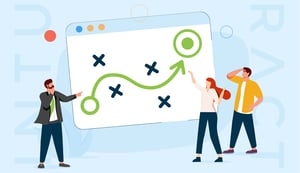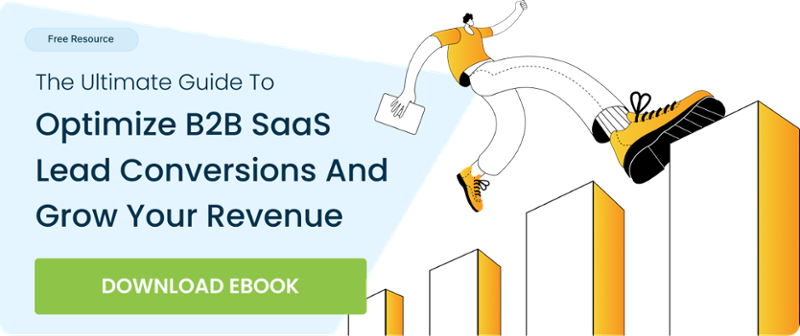Only a growing business can sustain itself in today’s stiff competition. Otherwise, it's more like a zombie counting its days to doom.
But is there a way to hack growth?
Unfortunately, quick tricks won’t give you lasting results. That’s why it’s essential to lay a solid foundation to build your success further. And it requires reliable strategies and the right execution.
In this article, we’ll see how to do precisely that to enjoy an exponential growth trend.
Is Scaling SaaS Businesses Different Than Others?
SaaS businesses aren’t like ice creams, which everyone loves and buys.
The biggest challenge while scaling a SaaS business is identifying your niche market and retaining those customers. Unlike a one-time transaction, you will have to give a reason to your customers to renew their subscriptions.
And since you are serving businesses rather than direct customers, you will have to tweak the product to satisfy the client’s requirement.
But is enhancing the product enough to win the race?
Unfortunately no.
A good product needs to be supported with
- Intuitive Interface- Your product design will ensure that the customers stick to your software and adopt it seamlessly into their processes.
- Marketing- Your marketing efforts shouldn’t be limited to just acquiring new leads. It should target nurturing client relationships and retaining them.
- Customer Service- SaaS businesses aim to have long-term relationships with clients, which is impossible without a dedicated team assisting them.
Running a SaaS business is difficult, but scaling it is another ball game altogether. Some quick sales and unoriginal marketing gimmicks aren’t enough. You need a serious strategy with a lot of patience to grow your business.
7 Proven Strategies For Scaling Your B2B SaaS Business
1. Reward Referrals With Incentives
The reason why every SaaS business loves referrals is simple– you get quality leads without a high acquisition cost.
Existing customers will only recommend your services to their friends and family if they are loyal and happy with your product. So, investing in building such a rapport with clients can get you significant headway among your competitors.
But what’s in it for your customers?
Incentivizing them for their part in promoting you will create a win-win situation for all parties. You can leverage either of the following as a reward for referrals.
- Declare a monetary reward to the clients referring you.
- A 15-30 days free access to the product.
- Discount on upcoming renewal.
- Credits or loyalty points that the client can redeem.
- Unlock premium features for a limited duration.
2. Strengthen Your Integration Capabilities
Integrations between two different solutions are neither cheap nor easy. But it’s a requirement that businesses can’t compromise with considering the seamless experience that makes data management a cakewalk.
The deeper your product is imbibed in the client’s processes, the more difficult it would be for them to switch to a competitor. That’s why B2B integrations are a massive opportunity for you to attract customers.
To claim your stake in the high-value client market, boost your product capabilities with third-party integrations. Research popular B2B softwares your target audience uses and reach out to them for partnership.
You can even refer those integration partners to your customers, making it a more lucrative deal for businesses.
3. Develop a Content Marketing Strategy
“The more content I put out, the more luck I have.” – Gary Vaynerchuk
Building a content strategy boosts your visibility in the market to attract potential clients and engage existing ones.
But randomly churning out words isn’t going to help. Instead, create content specifically made for your clients related to their buying stage.
The B2B customer lifecycle comprises four stages, and their content requirements differ at each of these.
- Awareness- It’s the phase when the customers have a business problem but aren’t sure of the possible solutions. The first thing they will do is Google it. And if your SEO-optimized blog is listed in the top result, leads will visit your landing page, thus boosting the chances of a purchase.
- Consideration- Once the client knows the possible solutions, the next thing to do is to research the market players who can help implement them. Effective email marketing with strong product demos is the key to standing apart from competitors.
- Decision- The moment of truth when the customer has to choose the best option. To seal the deal, use competitive analysis, case studies, and an attractive proposal. An easy way to create a great one is taking one of the proposal templates you can find online and customizing it according to your business.
- Retention- The work doesn’t end once the client has been onboarded. The real challenge is to retain them to justify the expenses of acquisition. Keeping them updated on new product additions and tutorials is a great way to maintain their interest in the product.
4. List Your Product on Growth-Hack Platforms
You name the problem, and ten businesses are providing a solution for it.
There are products to search for other products you can use for your business optimization.
The most popular ones are LinkedIn, ProductHunt, and G2.
73% of buyers consider those brands seriously which reach out to them through LinkedIn. You can build your presence on LinkedIn to represent your company values and product strengths.
LinkedIn is also a great channel to share your content in the form of articles, long-form blogs, videos, etc. Along with that, you can build your prospect database by researching the decision-makers for your ideal customers.
ProductHunt and G2 are the platforms which list the products available in the market for each problem statement. Its users write their reviews and vote for better products to help others make unbiased decisions.
Ask your customers to share their feedback on such public platforms to build your positive presence.
5.Personalize Your Landing Pages
Different industries might be using your product, but a new visitor isn’t going to scroll through all the use cases on your website. They don’t have time and interest to know about anything that doesn’t concern them.
Personalized landing pages can get you a big win here by giving the potential customers precisely what they need.
To make it a success, identify your buyer personas and tailor the landing pages for them.
What should your landing page have?
- A headline to catch the attention
- A subheadline that details the value proposition in a few words
- The product images, along with solid benefits
- Assure potential customers with authentic social proofs
- Reinforce the unique selling points of your product
- Provide the action button with a closing statement
6. Upscale With Upsells
About 44% of the businesses agree that they get over 10% of their new revenue from upselling and cross-selling.
All SaaS products upgrade with time to stay relevant among their customers. But simply adding features for a handful of your clients doesn’t make sense considering returns on investment.
That’s why all successful businesses focus on retaining and upselling their subscribers, especially the high-value ones. The top cream of your customer base is the one that has the money to spend and processes to optimize, so it makes sense to pay extra attention to them.
But how to get started?
- Randomly popping up to ask them to buy a bigger plan won’t work. Instead, maintain regular communication with them to establish rapport and trust.
- Share regular product updates through email. Elaborate with the help of reference documents and videos and include laptop mockups for visual introduction.
- Ask for time to showcase the feature demo.
- Compliment the new update with how it can help the client specifically. Create the need for the feature.
- Offer a bundle solution with some discount to entice the client to purchase.
7. Serve Better With the Customer Success Team
Your sales team is responsible for bringing in new clients. But who will ensure that they stay with you?
Expecting the customers to navigate the product themselves isn’t fair.
That’s where a dedicated team for customers comes into the picture, called customer success.
Is it worth setting up a new team? A big yes, and let’s see why.
- To ensure a smooth client onboarding.
- To train them on the product’s features.
- To help with product adoption by suggesting meaningful tips.
- To forecast churn with regular health checks.
- To analyze the account performance with quarterly and monthly business reviews.
- To spot opportunities for upselling and cross-selling.
All this is not something you can’t expect to happen itself. So, setting up a customer success team is an investment worth pursuing.
The Red Flags For Your B2B SaaS Scaling
The shortcut to success is avoiding the mistakes made by other businesses.
If you are not taking preventive measures, you will spend double the time and resources fixing the blunder.
First of all, start with your product. See if it’s designed aptly to make adoption easier for the customers. Anything complex that the client can’t figure out after one training session needs to be replaced with a simpler version.
Then, take a look at your sales strategy. Are you just focusing on acquiring customers, or is retention also a part of your business plan?
And finally, bring in the top talent to help you scale your business. If hiring seems like another chore, you can outsource industry experts to accelerate your growth plan. For more information on how to optimize your lead conversions and grow your revenue, check out the ultimate guide to optimize B2B SaaS lead conversions and grow your revenue.



